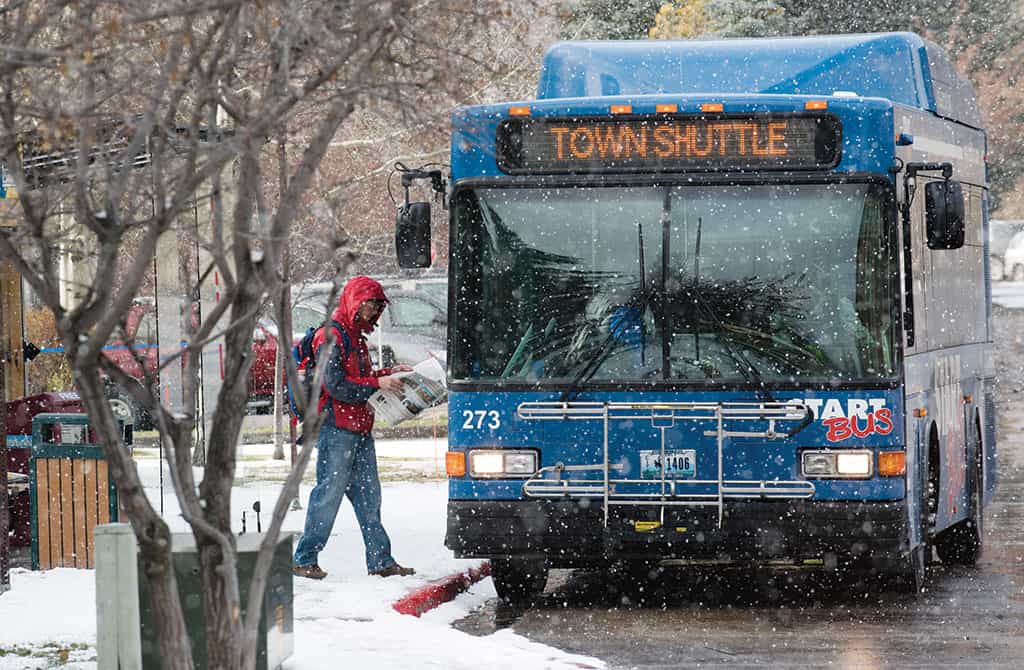Read The
Current Issue
Jackson Hole by Bus
Ride the bus between Jackson and Teton Village and enjoy a classic Jackson Hole experience.
BY Maggie theodora

IT’S ALMOST TEN o’clock at night. Teton Village is still and silent with one exception: its bus stop, which is packed. Despite the fact the lifts closed nearly six hours ago, some waiting passengers are still in their ski and snowboard gear, including boots. These champion après-skiers, all reeking of beer, are in two categories: the long day caught up with two of them, who slump on the benches inside the covered waiting area; three others are still going strong, beers in hand, loudly talking about how hard they shredded the slopes that day and oblivious to the frigid temperatures. Not one of them is wearing a hat or gloves.
While the drunk skiers are the loudest, they’re not so loud as to drown out snippets of languages other than English. A handful of twenty-something guys speaks in Japanese. A cluster of what is most likely a group of students here working at the ski resort or one of the hotels at the base on J-1 visas chatters in Spanish. From their accents it’s likely they’re from Argentina. Four Latino women in their thirties and forties giggle more than they talk. A fifty-something couple, both wrapped in long, black, down coats, speak quietly in French.
When the bus, which is a Red Line, the route with the greatest coverage of East Jackson, pulls up, a cheer led by the skiers still drinking reverberates through the base area.
The valley’s START—Southern Teton Area Rapid Transit—buses efficiently get riders around Jackson (the Town Shuttle) and between Jackson and Teton Village (four routes: green, red, yellow, and blue) and also between Jackson and Star Valley and Jackson and Teton Valley (commuter routes). In winter, when there are one hundred daily trips between town and Teton Village (compared to nineteen daily trips during summer), a START ride doubles as a not-to-be-missed experience. After all, it is the busiest transit system in the state. “We do five thousand rides a day in winter,” says shift supervisor Tom Guheen, who has worked for START since 1999. “Few other areas in the state have a public transit system, and they don’t come anywhere close to our numbers.”
START WAS FOUNDED in 1987 as a winter-only enterprise. The idea was to get local and visiting skiers living/staying in town to the Jackson Hole Mountain Resort in Teton Village. Its first year, it had no buses of its own. “We used the buses that whitewater companies used in the summer,” Guheen says. Within a couple of years, START bought a handful of its own buses.
The next big milestone was around the turn of the millennium—the addition of the Town Shuttle, a free service with stops in East and West Jackson that brings riders from outside the downtown area to hubs where they can then connect to buses going to Teton Village. “Say a bus to Teton Village starts at Snow King Resort. You get on there and thirty-four minutes later, you’re at Teton Village,” Guheen says. “What if that bus had to go to the high school or meander around town for an hour and a half? Then no one would ride it. That’s where the Town Shuttle comes in, bringing riders to central hubs like Kmart.”
By 2002, annual ridership was up to about two hundred thousand, and, in winter, there were about thirty-seven daily trips between town and Teton Village.
In 2014, the most recent year for which stats are available, nearly one million people rode a START bus. Transit staff calculated this kept enough cars off the road that 143,000 gallons of gas were saved. That equates to saving 2.45 million pounds of carbon emissions. Today, the START fleet includes twenty-nine vehicles—including the state’s first hybrid buses and nearly one dozen buses with Wi-Fi. In December 2014, START got a new 42,000-square-foot transit center/headquarters. START employees call it the “bus barn.” “We can park the entire fleet in there at night now,” Guheen says. Prior to the transit center, every winter morning START’s fleet idled in an open parking lot as the buses warmed up.
“The bus barn is the most awesome building in Jackson,” Guheen says, being completely serious. “These buses used to be outside in 10- to 20-degree-below-zero weather all winter long. Now they’re inside in a heated environment. It is hard to appreciate it, but these buses are a good size. Imagine if you left the windows and doors of your house open all night and then at 6 a.m. turned on the heat to try and get the house warm. That’s kind of what it was like with these buses. Finally, after a couple of hours, the heat would get going. The new building is a much better situation.” Bus repairs are also down, as is maintenance. The opportunity for people watching is as high as ever, though.




